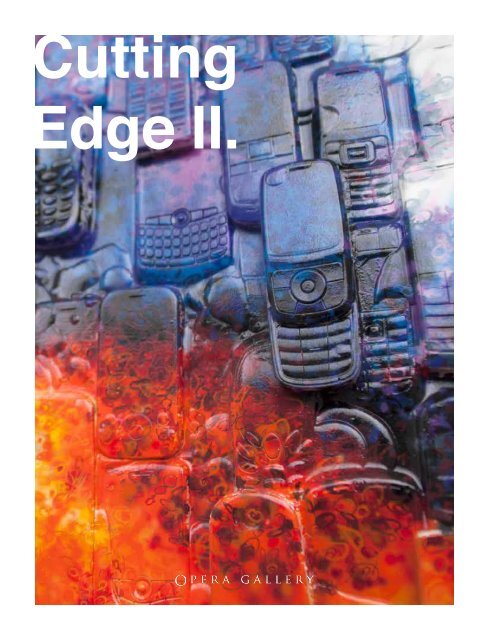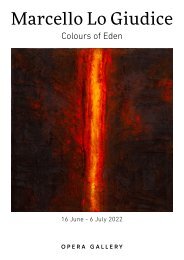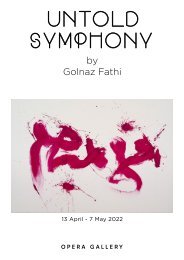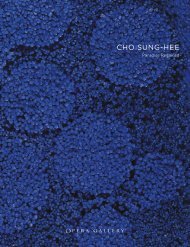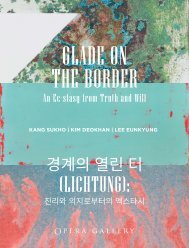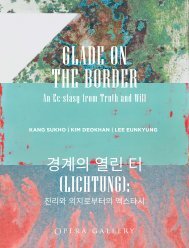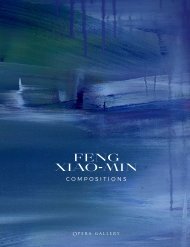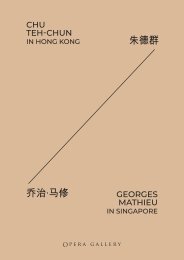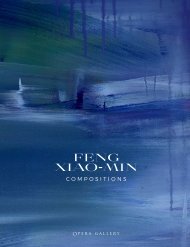Catalogue Cutting Edge II
Parallel to the invariable progress of humanity, time has brought resounding developments to the world of art-making. Traditional barriers that once held an artist in place have gradually expanded to encompass innovative techniques, ideologies and forms of expression. The definition of art has also changed, allowing new visions and perspectives. In this second installment of the group show, Cutting Edge II brings to life the creative endeavour of a curated selection of artists, whose works challenge the traditional boundaries of art. Experimenting with textures, materials and technology alongside traditional mediums, these Contemporary artists draw in their audiences through a feast of the senses, giving art a renewed dimension and direction.
Parallel to the invariable progress of humanity, time has brought resounding developments to the world of art-making. Traditional barriers that once held an artist in place have gradually expanded to encompass innovative techniques, ideologies and forms of expression. The definition of art has also changed, allowing new visions and perspectives.
In this second installment of the group show, Cutting Edge II brings to life the creative endeavour of a curated selection of artists, whose works challenge the traditional boundaries of art. Experimenting with textures, materials and technology alongside traditional mediums, these Contemporary artists draw in their audiences through a feast of the senses, giving art a renewed dimension and direction.
Create successful ePaper yourself
Turn your PDF publications into a flip-book with our unique Google optimized e-Paper software.
<strong>Cutting</strong><br />
<strong>Edge</strong> <strong>II</strong>.<br />
1
<strong>Cutting</strong> <strong>Edge</strong> <strong>II</strong>.<br />
11 - 19 JANUARY 2020<br />
2 3<br />
Joe Black, Hashtag (detail)
Foreword.<br />
Running parallel to the inevitable progress of humanity, time has brought<br />
resounding developments in the world of art-making. Traditional barriers<br />
that once held an artist in place, have gradually expanded to encompass<br />
innovative techniques, broader ideologies and wider forms of expression.<br />
The definition of art has also continued to change, allowing for new visions<br />
and perspectives.<br />
<strong>Cutting</strong> <strong>Edge</strong> <strong>II</strong>, the second installment of this group exhibition, brings to life<br />
the creative endeavour of a curated selection of artists. Experimenting with<br />
textures, materials and the use of technology alongside more traditional<br />
methods and mediums, these contemporary artists provide their art with a<br />
renewed dimension and direction, captivating their audiences with a feast<br />
for the senses.<br />
Superseding its formerly inescapable and absolute properties, light has<br />
become a manipulatable medium in today’s art world. Light-based works<br />
speak a new language, particularly though the hypnotic sculptures of Anthony<br />
James, the refined LED-lit etchings of Tatyana Murray and the paintings of<br />
Son Bong-Chae. Moreover, the motion in stillness is explored and expressed<br />
through the impactful video installations of Fabrizio Plessi, together with<br />
Han Jin-Ping’s whimsical take on classical works. Not only redefining the<br />
everyday functions of technology, this exhibition also sees artists like David<br />
Mach and Joe Black taking mass-produced objects and turning them into<br />
remarkable works that make a statement on our consumption and reliance<br />
on technology.<br />
Collectively, <strong>Cutting</strong> <strong>Edge</strong> <strong>II</strong> unveils an evocative, interdependent relationship,<br />
between these artists and a society where influence and engagement is<br />
locked in a ring of cause and effect. As we ponder over the art of today, it<br />
poses an intruging discourse for the art of the future, as we move forward<br />
into a bright and exciting new decade.<br />
Gilles Dyan<br />
Founder & Chairman<br />
Opera Gallery Group<br />
Stéphane Le Pelletier<br />
Director Asia-Pacific<br />
Opera Gallery<br />
4 5<br />
David Mach, A Tretchikoff Woman with Mona Lisa Postcards (detail)
BAE JOON SUNG<br />
B. 1967<br />
Bae Joon Sung is a Korean artist whose work is<br />
about binaries. European Classicism and global<br />
Modernism; West and East; phantom and concrete.<br />
Familiar Western figures appear as Korean women,<br />
both they and the image stripped of their original<br />
condition. Using the unique optical technique of<br />
lenticular effects Bae’s work include the viewer in an<br />
active relationship with the artwork: as the viewer<br />
moves, the picture evolves. Nourishing two popular<br />
subjects of human voyeurism – the observation of<br />
the nude and the visual consumption of culture in<br />
museums and galleries – Joon Sung’s paintings<br />
explore how we see and think about what we see in<br />
different contexts.<br />
Utilising the dynamics of space, environment and<br />
viewer, Joon Sung’s "meta-canvases" both evoke and<br />
challenge conventional methods of observations and<br />
perception. In vivid detail and curious composition,<br />
the artist emphasises the museum setting as a<br />
complex setting that suspends the past in the<br />
present. Using European architecture, artworks and<br />
clothing as a setting onto which he strategically<br />
places his Korean models, the artist also discusses<br />
the pervasion of the west in artistic classicism and<br />
the gradual shift towards more inclusive, global and<br />
cross-historical experiences of art.<br />
6 7
BAE JOON SUNG<br />
The Costume of Painter - Still Life with Wine Glass<br />
Lenticular - Oil on vinyl on photograph<br />
Edition of 5<br />
135 x 120 cm - 53.1 x 47.2 in<br />
provenance<br />
Artist’s studio<br />
8 9
BAE JOON SUNG<br />
The Costume of Painter - J. L. David Drawing Coronation<br />
Lenticular - Oil on vinyl on photograph<br />
Edition of 5<br />
95 x 120 cm - 37.4 x 47.2 in<br />
provenance<br />
Artist’s studio<br />
10 11
JOE BLACK<br />
B. 1973<br />
Joe Black is a British Contemporary artist whose<br />
iconic large-scale, mosaic-like work is the vanguard<br />
of the current Pop Art movement. He describes his<br />
work as “revealing the unexpected” as his œuvres are<br />
viewed both from a distance and up close to make<br />
the ordinary extraordinary.<br />
Black combines his natural craft skills with a love<br />
of materials –many of which are recognizable<br />
everyday objects– to create portraits and works<br />
at the crossroad of Figurative and Abstract Art.<br />
Using a work-intensive technique of hand painting<br />
and altering each tiny object to give gentle lines<br />
and shading to his subjects, Black has pioneered<br />
an elaborate new form of pixelation that he uses to<br />
hide subtle implications within each of his images. It<br />
is through minute work on colour superposition and<br />
contrast that Black manages to create tones, depth,<br />
and ultimately a whole chromatic world.<br />
Black’s distinctive style encourages the viewer to<br />
interpret his playful works by exploring the piece as a<br />
dramatic whole, as well as by examining the intricate<br />
collection of its parts. His unparralleled attention<br />
to details make his installations worthy of interest<br />
equally from afar and up close, reinterpretatin how<br />
we apprehend imagery and images.<br />
12 13
JOE BLACK<br />
Blue Lady - Nude Study 2<br />
2016<br />
Handmade badges depicting nudes, set on aluminium<br />
161 x 107 x 6 cm - 63.4 x 42.2 x 2.4 in<br />
provenance<br />
Artist’s studio<br />
14 15
JOE BLACK<br />
Millions Like Us<br />
2018<br />
Hand-painted toy soldiers on aluminium with resin and high gloss lacquer coating<br />
164 x 164 x 8 cm - 64.6 x 64.6 x 3.1 in<br />
provenance<br />
Artist’s studio<br />
Following pages: detail of the artwork<br />
16 17
JOE BLACK<br />
Effect<br />
2018<br />
Hand-painted crushed toy cars on aluminium<br />
123 x 161 x 6 cm - 48.4 x 63.4 x 2.4 in<br />
provenance<br />
Artist’s studio<br />
20 21
JOE BLACK<br />
Hashtag<br />
2018<br />
Hand-painted mobile phones on aluminium<br />
186 x 131 x 9 cm - 73.2 x 51.6 x 3.5 in<br />
provenance<br />
Artist’s studio<br />
22 23
JOE BLACK<br />
Army of Shadows<br />
2018<br />
Hand-painted toy soldiers on aluminium<br />
185 x 146.5 x 8 cm - 72.8 x 57.7 x 3.1 in<br />
provenance<br />
Artist’s studio<br />
24 25
ANTHONY JAMES<br />
B. 1974<br />
Anthony James is a British-born, Los Angeles-based<br />
multi-media artist. He studied at Central St. Martins<br />
School of Art in London. He has exhibited at Patrick<br />
Painter, Los Angeles, Gavlak, West Palm Beach,<br />
Kantor/Feuer, New York, Art Basel, Marc Selwyn,<br />
Los Angeles, Blum and Poe, Los Angeles, The New<br />
Museum, New York, Spencer Brownstone Gallery,<br />
New York and Thread Waxing Space, New York.<br />
Anthony James’ first monograph, morphic fields,<br />
was published by Hatje Cantz in 2014.<br />
Icosahedrons –the geometric globes of twenty<br />
identical triangular facets– were a mathematical<br />
experiment in unity used by Plato to demonstrate<br />
an ideal compositional system of perfect symmetry<br />
in three dimensions. In a twenty-first century gallery<br />
space, the glass, steel, and LED structures bring a<br />
rigid and gleaming tangibility to the abstraction<br />
of the numerical calculation of flawless coherence.<br />
James’ objects are compelling approximations,<br />
facsimiles of understanding and belief thousands of<br />
years old that come down to us on our own terms of<br />
modern metals and technological light.<br />
The works of Anthony James are a literal dive into<br />
other worlds, gates to hypnotic depth and radiant<br />
voids, in a journey to new aesthetics.<br />
26 27
ANTHONY JAMES<br />
50” Octagon Wall Portal<br />
2019<br />
Stainless steel, specialised glass, LED lights<br />
Edition of 6<br />
127 x 127 x 38.1 cm - 50 x 50 x 15 in<br />
provenance<br />
Artist’s studio<br />
Following pages: Anthony James, Icosahedron (detail)<br />
28 29
ANTHONY JAMES<br />
80” Icosahedron<br />
2019<br />
Stainless steel, specialised glass, LED lights<br />
Edition of 6<br />
203.2 x 203.2 x 203.2 cm - 80 x 80 x 80 in<br />
provenance<br />
Artist’s studio<br />
32 33
FRANCK KELLER<br />
B. 1973<br />
Urban sensuality can be used to describe the<br />
photographs of French artist Franck Keller. Born in<br />
1973 in Saint-Tropez, France, the artist depicts the<br />
dark fluid silhouettes of the female form, striking a<br />
strong contrast against the bold city skyline. Like<br />
a scene out of a music video, Keller’s style could<br />
be traced from his pop star days when he traveled<br />
the world with his band “Bel Amour”, playing their<br />
unique blend of house music.<br />
Having produced video clips and worked in the<br />
American film industry, the influence of film and<br />
videography is highly evident in Keller’s photographs,<br />
especially through his signature lighting technique.<br />
Through the use of lighting and new angles, Keller’s<br />
work captures the feminine sensual forms of his<br />
subjects in an original interpretation that is timeless<br />
and trendy at the same time. Using light boxes to<br />
give depth and magnetism to his photographs, and<br />
provides a whole new dynamic to the medium.<br />
Keller is considered as one of the most promising<br />
young photographers today. Keller’s work has won<br />
him the admiration of an international and renowned<br />
clientele, which includes Peter Beard, Valerio Adami,<br />
Peter Klasen, and Jacques Monory, among others.<br />
34 35
FRANCK KELLER<br />
Serie 1209 - 1<br />
Diasec on light box with wooden frame<br />
127 x 127 cm - 50 x 50 in<br />
provenance<br />
Artist’s studio<br />
36 37
FRANCK KELLER<br />
Serie 1209 - 4<br />
Diasec on light box with wooden frame<br />
127 x 127 cm - 50 x 50 in<br />
provenance<br />
Artist’s studio<br />
38 39
FRANCK KELLER<br />
Serie 1209 - 7<br />
Diasec on light box with wooden frame<br />
127 x 83 cm - 50 x 32.7 in<br />
provenance<br />
Artist’s studio<br />
40 41
DAVID MACH<br />
B. 1956<br />
David Mach is a Scottish artist known for his<br />
dynamic and imaginative large scale artworks<br />
and installations. His diverse practice includes<br />
everyday mass-produced objects repurposed to<br />
form cluttered collages, photographic montages<br />
of densely populated urban landscapes, figurative<br />
sculptures made of coat-hangers, and animal heads<br />
constructed with matchsticks, sometimes set on<br />
fire in performances. Mach’s work brings popular<br />
cultural imagery under the lens, suggesting social<br />
commentary but ultimately taking ambiguous<br />
positions on its subjects.<br />
His theatrical yet universally relatable pieces are, in<br />
part, inspired by the work of the Pop Art movement –<br />
depicting everyday culture through everyday materials.<br />
In 2003, Mach’s Arm’s Length sculpture of a woman<br />
made of coat hangers won the Jack Goldhill Award for<br />
sculpture at the Royal Academy Summer Exhibition.<br />
In 2004, he was elected an honorary member of<br />
the Royal Scottish Academy and the same year<br />
the University of Dundee appointed him Professor<br />
of Inspiration and Discovery. From 2006 to 2010,<br />
he was a Trustee of the National Portrait Gallery. In<br />
2011, Mach was awarded the Bank of Scotland Herald<br />
Angel Award for his exhibition ‘Precious Light’, as<br />
well as the Glenfiddich Spirit of Scotland Award.<br />
42 43
DAVID MACH<br />
A Tretchikoff Woman with Mona Lisa Postcards<br />
2008<br />
Postcards on wood<br />
190 x 190 x 11 cm - 74.8 x 74.8 x 4.3 in<br />
provenance<br />
Artist’s studio<br />
Following pages: David Mach, Eastern Promise (detail)<br />
44 45
DAVID MACH<br />
Eastern Promise<br />
2009<br />
Postcards on wood<br />
190 x 190 x 11 cm - 74.8 x 74.8 x 4.3 in<br />
provenance<br />
Artist’s studio<br />
48 49
DAVID MACH<br />
Mao<br />
2008<br />
Postcards on wood<br />
150 x 150 cm - 59.1 x 59.1 in<br />
provenance<br />
Artist’s studio<br />
50 51
DAVID MACH<br />
Chinese Portrait<br />
2011<br />
Postcards on wood<br />
152.4 x 152.4 cm - 60 x 60 in<br />
provenance<br />
Artist’s studio<br />
52 53
DAVID MACH<br />
Silver Streak (Standing Gorilla)<br />
2010<br />
Coat hangers<br />
Edition of 3<br />
302 x 240 x 160 cm - 118.9 x 94.5 x 63 in<br />
provenance<br />
Artist’s studio<br />
54 55
DAVID MACH<br />
Van Gogh<br />
2011<br />
Coat hangers<br />
Edition of 4<br />
50 x 65 x 80 cm - 19.7 x 25.6 x 31.5 in<br />
provenance<br />
Artist’s studio<br />
56 57
DAVID MACH<br />
Green Marine<br />
2012<br />
Pin heads on foam<br />
Unique piece<br />
60 x 34 x 34 cm - 23.6 x 13.4 x 13.4 in<br />
provenance<br />
Artist’s studio<br />
58 59
DAVID MACH<br />
Yellow Sucker<br />
2012<br />
Pin heads on foam<br />
Unique piece<br />
30.5 x 21 x 21 cm - 12 x 8.3 x 8.3 in<br />
provenance<br />
Artist’s studio<br />
60 61
TATYANA MURRAY<br />
B. 1973<br />
Tatyana Murray is a British artist that now lives and<br />
works in New York. In her most recent Light series,<br />
etherial images are created by precise yet deep<br />
scratching and drilling of several pellucid sheets that<br />
are then piled up in a consciously defined order. The<br />
light source of LED Lights set in the frame create a<br />
delicate floating image of refracted light set neither<br />
in time nor space, revealing themselves like veils.<br />
Without the light source the image cannot exist. It is<br />
but the positivity of negative space.<br />
The repetitive pattern making is a meditative<br />
process, self-informing itself as the piece evolves. The<br />
geometric and circular patterns, almost reminiscent<br />
of fractal imagery, give rise to question whether<br />
they are something grown or man made, exploring<br />
a microcosmos in which forms continually verge on<br />
collapse and rearrangement, creating a constant<br />
flux. The work oscillates between macro and micro<br />
scales, spiraling in and out of control, but at the heart<br />
of this disorienting movement lies stillness. Radiant<br />
gateways to introspection, the Light series invites to<br />
a moment of wonder and calm.<br />
62 63
TATYANA MURRAY<br />
Ghost Willow Tree (Red)<br />
Mixed media<br />
113 x 123.2 x 15.2 cm - 44.5 x 48.5 x 6 in<br />
provenance<br />
Artist’s studio<br />
64 65
TATYANA MURRAY<br />
Ghost Tree<br />
Mixed media<br />
73.7 x 99 x 9.5 cm - 29 x 39 x 3.7 in<br />
provenance<br />
Artist’s studio<br />
66 67
TATYANA MURRAY<br />
Ghost Willow Tree (White)<br />
Mixed media<br />
116 x 106 x 18 cm - 45.7 x 41.7 x 7.1 in<br />
provenance<br />
Artist’s studio<br />
68 69
NAKAO MASAKI<br />
B. 1959<br />
Nakao Masaki was born in 1959 in Nagoya, Japan.<br />
Destined to be an athlete when he was young, he<br />
operated a major change in his career plans following<br />
a series of injuries. First attracted by charcoal<br />
drawing techniques, Nakao quickly moved on to<br />
sculptures and installations, which he then taught<br />
at Nagoya University after completing his degree at<br />
Nihon University, in Tokyo.<br />
In his artistic practice, Nakao creates sculptureobjects<br />
in luminous materials and in transparent<br />
plastics in pastel colours that were to become the<br />
characteristic signature of his expressive means and<br />
of his sculptural vocabulary. Based on neon tubes, his<br />
pieces fall at the crossroads of art objects, and interior<br />
design, following his firm intention to dematerialise<br />
space, to better perceive frailty of colours, of<br />
structure, and light. A convinced modernist and<br />
minimalist, he seeks to abolish the frontier between<br />
the surrounded and the surroundings, irradiating his<br />
sculpture-objects via light to show up the work’s<br />
poetic visibility and subtlety.<br />
Nakao Masaki is and remains one of the most talented<br />
Japanese sculptors of his generation. He is exhibited<br />
and acclaimed all around the world, with interest<br />
coming from both public and private art circles. He<br />
currently lives in Düsseldorf.<br />
70 71
NAKAO MASAKI<br />
Syncret<br />
2007<br />
Polyester, acrylic, neon lights<br />
205 x 230 x 210 cm - 80.7 x 90.5 x 82.7 in<br />
provenance<br />
Artist’s studio<br />
72 73
FABRIZIO PLESSI<br />
B. 1940<br />
Fabrizio Plessi was born in 1940 in Reggio Emilia, in<br />
Italy. He enrols in the Venice Academy of Fine Arts,<br />
where he then teaches painting; he focuses his own<br />
artistic practice around the topic of water, which he<br />
represents in installations, videos, and performances.<br />
He firsts showcases his work in the experimental<br />
pavilion at the 35 th Art Biennale in Venice in 1970.<br />
Since then, he regularly and successfully exhibits his<br />
works at the Biennale. With his movie ‘Liquid Movie’<br />
he wins the Città di Milano prize at the Venice Film<br />
Festival in 1980. A year later, his artwork is exhibited<br />
in its integrity at the Centre Pompidou. Throughout<br />
his career, he also realises costumes and stage decors<br />
for theatre and opera pieces, in Italy and abroad.<br />
In 2005, for the 51 st Venice Biennale and in<br />
collaboration with the Ministry of Foreign Affairs,<br />
he presents in the Giardini his piece ‘Mare Verticale’,<br />
a 44-meter-high digital waterfall, which will in turn<br />
become the symbol of the Biennale.<br />
A retrospective titled ‘Traumwelt’ is dedicated to him<br />
at the Martin Gropius Bau museum in Berlin in 2004.<br />
In 2014, the city of Milan pays tribute to his work at<br />
the Fondazione Mudima with the exhibition ‘Plessi,<br />
the Seventies’.<br />
74 75
FABRIZIO PLESSI<br />
Acqua che Sale<br />
Video installation<br />
163 x 163 cm - 64.2 x 64.2 in<br />
provenance<br />
Artist’s studio<br />
76 77
RISK<br />
B. 1967<br />
Kelly Graval is a Los Angeles-based artist usually<br />
known by his graffiti tag and artist name RISK. He<br />
was one of the first artists to exhibit graffiti and<br />
street art in galleries. He is also known as one of the<br />
biggest names in the street art and graffiti scene in<br />
the United States.<br />
With a background in fine art, RISK has a style<br />
defined by neat lettering paired with graphic imagery<br />
and architectural lines. He has been a known part of<br />
a number of street art crews, most famously West<br />
Coast Artists (WCA) and the Seventh Letter.<br />
Involved in various Hollywood projects and getting<br />
more recognition outside of the graffiti world, such<br />
as film sets and videos, RISK then started to paint his<br />
graffiti on canvases. He co-founded the Third Rail, a<br />
series of art gallery shows, then turned the name into<br />
a successful graffiti-inspired clothing brand.<br />
He is also considered one of the first artists to have<br />
painted on freight trains, as well as a pioneer of<br />
“painting in the heavens”–a graffiti term referring<br />
to highly elevated surfaces like billboards, rooftops,<br />
and overpasses. In the course of his nearly 30-year<br />
career, RISK has become one of the most influential<br />
figures for subsequent generations of graffiti artists.<br />
78 79
RISK<br />
Good Times Seris, Thumb 2<br />
2012<br />
Acrylic on aluminium plate with neon<br />
122 x 122 cm - 48 x 48 in<br />
provenance<br />
Artist’s studio<br />
80 81
SON BONG-CHAE<br />
B. 1967<br />
Son Bong-Chae is a South-Korean artist born in<br />
1967. He received attention as the youngest artist<br />
to participate in the Gwangju Biennial in 1997 for<br />
pioneering the genre of 3D painting. His work<br />
style is different from the traditional paintings on<br />
canvas in that it is composed of multiple numerous<br />
layers of painted bulletproof glass to give it a more<br />
3-dimensional look.<br />
Migrants is the exemplary work that embodies his<br />
signature style of 3D paintings. On five layers of<br />
polycarbonate, Son meticulously paints a pulled<br />
out pine tree and uses luminescent diodes to shine<br />
over the image. Migrants is reminiscent of traditional<br />
Korean painting composed of Chinese ink on Korean<br />
traditional paper. His works are not a mere act of<br />
layering landscapes, but specially dividing one scene<br />
into five different sides. These layers echo his vision,<br />
considering each sheet a division of time and space.<br />
Son Bong-Chae’s characteristic 3D paintings are<br />
regularly exhibited in international art faire such as<br />
the Swiss Basel Art Fair, Miami Art Basel, Spain Arco<br />
Art Fair, Germany’s Cologne Art Fair among many<br />
others. He had the honour of being nominated as Art<br />
Basel’s Rising artist of the year in 2011.<br />
82 83
SON BONG-CHAE<br />
Migrants<br />
2017<br />
Oil on polycarbonate, LED<br />
84 x 124 cm - 33.1 x 48.8 in<br />
provenance<br />
Artist’s studio<br />
84 85
STALLMAN<br />
Jason Hallman and Stephen Stum are the two artists<br />
behind the portmanteau name Stallman. Created in<br />
2012, the artistic entity now produces unprecedented<br />
artworks, redefining canvases. Carefully dyeing and<br />
folding long and thin strips of fabric, they completely<br />
reinvent the medium, and give a new role and a<br />
new light to what we usually consider as a mere<br />
supporting surface.<br />
Completely complementary, the duo acts like<br />
both hemispheres of the brain, and together they<br />
work to create pieces halfway between paintings<br />
and sculptures. The rich gradients featured in<br />
their works act as epitomes of the hues present in<br />
nature, channelling the very essence of the beauty<br />
around us. “We create together, one acting as the<br />
right side of the brain and the other the left,” says<br />
Stallman. “This union of dynamic minds dissolves the<br />
boundaries of what is possible, turning the ordinary<br />
into extraordinary.”<br />
The duo attributes much of their inspiration to the<br />
color theorists of the 1950s and 1960s, specifically<br />
Josef Albers, the German American painter and<br />
art theorist who argued that colour, due to its<br />
inseparability from its surroundings, is the most<br />
relative medium in art.<br />
86 87
STALLMAN<br />
Infrared 1 and 2 (Diptych)<br />
Sculpted canvas and acrylic paint<br />
121.9 x 152.4 cm - 48 x 60 in<br />
provenance<br />
Artist’s studio<br />
Following pages: Stallman, Infrared 2 (detail)<br />
88 89
STALLMAN<br />
Opalescence<br />
Sculpted canvas and acrylic paint<br />
61 x 182.9 cm - 24 x 72 in<br />
provenance<br />
Artist’s studio<br />
92 93
STALLMAN<br />
Move with Me <strong>II</strong><br />
Sculpted canvas and acrylic paint<br />
61 x 152.4 cm - 24 x 60 in<br />
provenance<br />
Artist’s studio<br />
94 95
YOO BONG SANG<br />
B. 1960<br />
Yoo Bong Sang was born in South Korea in 1960<br />
where he still resides. He trained at the Seoul National<br />
University after which he spent a number of years<br />
living and working in France.<br />
Yoo’s artworks combine the artist’s vision, his own<br />
photography and a laborious process, which involves<br />
penetrating a support of plywood on welded<br />
aluminium with thousands and thousands of nails in<br />
order to create the pixels of an image. On average<br />
300,000 pins are used to create these perplexing<br />
and beguiling images.<br />
His works are landscapes at a large scale, yet they also<br />
are abstracts. He has discovered a point of balance<br />
in which Figurative and Abstract art meet, and do<br />
not compete. Yoo nails down hiw wooden boards the<br />
pathway to a new dialectical relation set between<br />
the continuity of life and the instantaneousness.<br />
Yoo Bong Sang was the recipient of the Pollock-<br />
Krasner Foundation Grant in 2001, and has been<br />
featured in numerous solo exhibitions in museums<br />
and galleries throughout Korea and Europe.<br />
96 97
YOO BONG SANG<br />
CY20150917<br />
2015<br />
Headless pins and acrylic on wood panel<br />
50 x 120 cm - 19,7 x 47.2 in<br />
provenance<br />
Artist’s studio<br />
Detail of the artwork in the following pages<br />
98 99
100 101
YOO BONG SANG<br />
HAN20170105<br />
2017<br />
Headless pins and acrylic on wood panel<br />
80 x 200 cm - 31.5 x 78.7 in<br />
provenance<br />
Artist’s studio<br />
102 103
YOO BONG SANG<br />
E20101001<br />
2010<br />
Nails and acrylic on wood panel<br />
50 x 120 cm - 19.7 x 47.2 in<br />
provenance<br />
Artist’s studio<br />
104 105
Published by Opera Gallery Singapore to coincide with exhibition ‘<strong>Cutting</strong> <strong>Edge</strong> <strong>II</strong>’,<br />
11 - 19 January 2020.<br />
All rights reserved. Except for the purposes of review, no part of this book may<br />
be reproduced, stored in a retrieval system, or transmitted, in any form or by any<br />
means, electronic, mechanical, photocopying, recording or otherwise, without the<br />
prior permission of the publishers.<br />
2 Orchard Turn, #02-16 ION Orchard, Singapore 238801<br />
+ 65 6735 2618 | spore@operagallery.com operagallery.com<br />
Stallman, Move with Me <strong>II</strong> (detail)<br />
106 107


